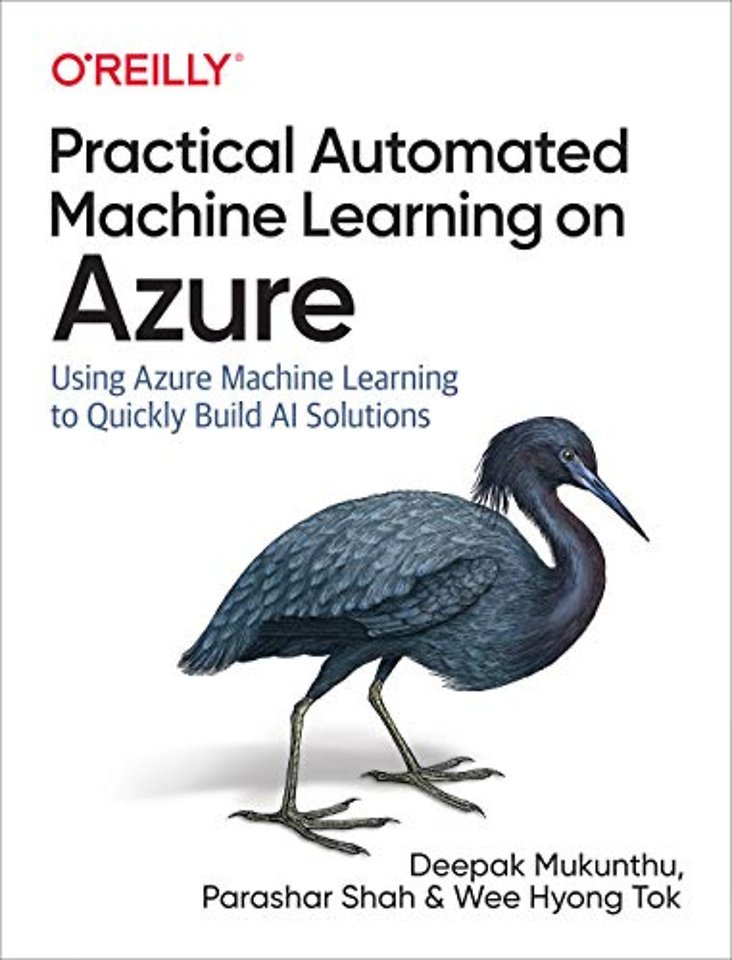


Deepak Mukunthu is a product leader with more than 16 years of experience. With his experience in big data, analytics, and AI, Deepak has played instrumental leadership roles in helping organizations and teams become data-driven and to adopt machine learning.
Meer over de auteursPractical Automated Machine Learning on Azure
Using AutoML to Build and Deploy Intelligent Solutions
Paperback Engels 2019 1e druk 9781492055594Samenvatting
Develop smart applications without spending days and weeks building machine-learning models. With this practical book, you’ll learn how to apply Automated Machine Learning, a process that uses machine learning to help people build machine learning models. Deepak Mukunthu, Parashar Shah, and Wee Hyong Tok provide a mix of technical depth, hands-on examples, and case studies that show how customers are solving real-world problems with this technology.
Building machine learning models is an iterative and time-consuming process. Even those who know how to create these models may be limited in how much they can explore. Once you complete this book, you’ll understand how to apply Automated Machine Learning to your data right away.
- Learn how companies in different industries are benefiting from Automated Machine Learning
- Get started with Automated Machine Learning using Azure
- Explore aspects such as algorithm selection, auto featurization, and hyperparameter tuning
- Understand how data analysts, BI professionals, and developers can use Automated Machine Learning in their familiar tools and experiences
- Learn how to get started using Automated Machine Learning for use cases including classification and regression.
Specificaties
Lezersrecensies
Over Parashar Shah
Over Wee-Hyong Tok
Inhoudsopgave
Preface
Conventions Used in This Book
Using Code Examples
O’Reilly Online Learning
How to Contact Us
Acknowledgments
I: Automated Machine Learning
1. Machine Learning: Overview and Best Practices
Machine Learning: A Quick Refresher
Model Parameters
Hyperparameters
Best Practices for Machine Learning Projects
Understand the Decision Process
Establish Performance Metrics
Focus on Transparency to Gain Trust
Embrace Experimentation
Don’t Operate in a Silo
An Iterative and Time-Consuming Process
Feature Engineering
Algorithm Selection
Hyperparameter Tuning
The End-to-End Process
Growing Demand
Conclusion
2. How Automated Machine Learning Works
What Is Automated Machine Learning?
Understanding Data
Detecting Tasks
Choosing Evaluation Metrics
Feature Engineering
Selecting a Model
Monitoring and Retraining
Bringing It All Together
Automated ML
How Automated ML Works
Preserving Privacy
Enabling Transparency
Guardrails
End-to-End Model Life-Cycle Management
Conclusion
II: Automated ML on Azure
3. Getting Started with Microsoft Azure Machine Learning and Automated ML
The Machine Learning Process
Collaboration and Monitoring
Deployment
Setting Up an Azure Machine Learning Workspace for Automated ML
Azure Notebooks
Notebook VM
Conclusion
4. Feature Engineering and Automated Machine Learning
Data Preprocessing Methods Available in Automated ML
Auto-Featurization for Automated ML
Auto-Featurization for Classification and Regression
Auto-Featurization for Time-Series Forecasting
Conclusion
5. Deploying Automated Machine Learning Models
Deploying Models
Registering the Model
Creating the Container Image
Deploying the Model for Testing
Testing a Deployed Model
Deploying to AKS
Swagger Documentation for the Web Service
Debugging a Deployment
Web Service Deployment Fails
Conclusion
6. Classification and Regression
What Is Classification and Regression?
Classification and Regression Algorithms
Using Automated ML for Classification and Regression
Conclusion
III. How Enterprises Are Using Automated Machine Learning
7. Model Interpretability and Transparency with Automated ML
Model Interpretability
Model Interpretability with Azure Machine Learning
Model Transparency
Understanding the Automated ML Model Pipelines
Guardrails
Conclusion
8. Automated ML for Developers
Azure Databricks and Apache Spark
ML.NET
SQL Server
Conclusion
9. Automated ML for Everyone
Azure Portal UI
Power BI
Preparing the Data
Automated ML Training
Understanding the Best Model
Understanding the Automated ML Training Process
Model Deployment and Inferencing
Enabling Collaboration
Azure Machine Learning to Power BI
Power BI Automated ML to Azure Machine Learning
Conclusion
Index
Anderen die dit boek kochten, kochten ook
Rubrieken
- advisering
- algemeen management
- coaching en trainen
- communicatie en media
- economie
- financieel management
- inkoop en logistiek
- internet en social media
- it-management / ict
- juridisch
- leiderschap
- marketing
- mens en maatschappij
- non-profit
- ondernemen
- organisatiekunde
- personal finance
- personeelsmanagement
- persoonlijke effectiviteit
- projectmanagement
- psychologie
- reclame en verkoop
- strategisch management
- verandermanagement
- werk en loopbaan





